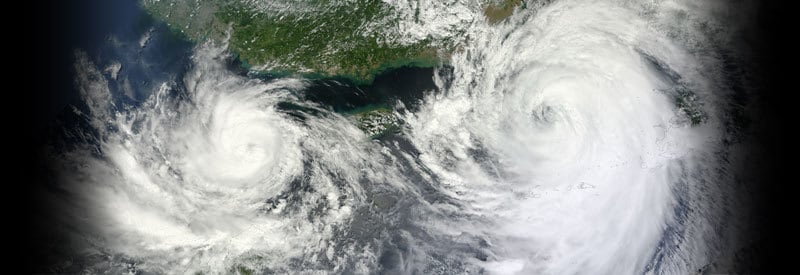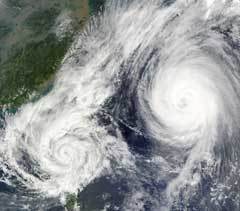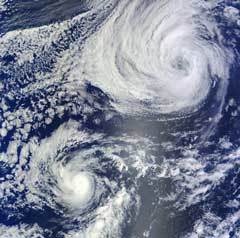The Fujiwhara Effect – When Two Hurricanes Meet

Viewers of weather forecasts may occasionally notice two big tropical cyclones close to each other on a weather map. The interaction between these two systems is better known as the Fujiwhara Effect.
The Fujiwhara Effect occurs when two tropical cyclones rotating in the same direction come in close proximity to each other. Their centers start to interact, which results in the distance between them closing. When the two systems are close enough, they merge or are deflected away from each other.
If you ever thought about what might happen if these two massive storm systems came too close to each other, you are not alone. This very question has been on the minds of many observers and not only studied by the meteorological community.
It also turned out to be a very valid question since tropical storms that come close enough to each other do start interacting and influencing each other. This phenomenon is called the Fujiwhara Effect (also known as the Fujiwara Effect).
In this article, we will examine what the Fujiwhara Effect is, how it develops, as well the different potential outcomes that can occur when two storm systems approach each other.
Fujiwhara Effect Definition
Before we get into the details, we first need to have a concise idea of what exactly the Fujiwhara Effect is:
What Is The Fujiwhara Effect?

The Fujiwhara Effect occurs when two tropical cyclones that rotate in the same direction get in close proximity to each other. Their centers start to interact, which results in the distance between them closing. When the two systems are close enough, they will merge or get deflected away from each other.
For this occurrence to take place, the distance between the two tropical cyclones must be within 1 400 kilometers (870 miles). In this space, the centers of both storms start to rotate each other around a common point while they get drawn to each other at the same time.
The processes involved in the development and different outcomes as a result of the Fujiwhara Effect will be discussed later in this post. Before we get to that, however, we need to address and clarify some potentially confusing storm names to avoid confusion.
Difference Between Hurricanes, Typhoons, And Cyclones
People often get confused or think that hurricanes, cyclones, and typhoons are entirely different storm systems. It can be problematic when describing a phenomenon like the Fujiwhara Effect, and these names get interchangeably used while discussing the event.
They are, in fact, one and the same type of storm. Meteorologists use the umbrella term, Tropical Cyclone, to describe all three occurrences.
The only reason these storms have different names is because of their location. Hurricanes, cyclones, and typhoons are named according to the region in which they occur:
- The storm is called a hurricane when it occurs in the central and eastern North Pacific or the North Atlantic Ocean.
- The storm is called a typhoon when it occurs in the Northwest Pacific region.
- The storm is called a cyclone when it occurs in the Indian or South Pacific Ocean.
These locations and naming can vary, depending on each region's unique classification and naming system.
It is important, though, to remember that all three names refer to the same type of storm system. It means that the Fujiwhara Effect refers to the interaction between the same two storms, whether they are called hurricanes, cyclones, or typhoons.
Consequences Of The Fujiwhara Effect

Dr Sakuhei Fujiwhara
The Fujiwhara Effect is named after Japanese meteorologist Dr. Sakuhei Fujiwhara, who first studied & identified the phenomenon in 1921. He was the first meteorologist to determine the tendency of two cyclonic storms to rotate each other around a common point.
Many factors influence the impact of the Fujiwhara Effect in different situations. We focus on the most important and common outcomes involving this phenomenon. Typically, three possible scenarios usually play out:
- Tropical cyclones of equal size and strength collide and merge.
- Tropical cyclones of equal size and strength collide and get diverted.
- Tropical cyclones with big differences in size collide, and one gets absorbed.
It will quickly become clear how these three different outcomes can occur when we look at each one in more detail:
1) Tropical Cyclones Of Equal Size And Strength, Collide And Merge
As already mentioned, when two tropical cyclones are in close enough proximity, they start to interact and are drawn towards each other. If both these storms are of equal size, their centers continue to gravitate towards each other, as they also rotate each other.
(Due to the Coriolis Effect, the rotation is counterclockwise in the Northern Hemisphere and clockwise in the Southern Hemisphere.)
When the two storm systems have closed the distance between them, the two centers (vortices) often merge to form a single storm.
More often than not, the merging of the storm centers has an additive effect. The result is a bigger and more powerful tropical cyclone, making it potentially more dangerous with increased destructive power and reach.
An example of this phenomenon occurred in 1994 when Tropical Storm Ruth interacted with Typhoon Pat in the Northwest Pacific. Their centers continued rotating closer to each other and eventually merged to form a single cyclonic storm system.
2) Tropical Cyclones Of Equal Size & Strength, Collide And Get Diverted
Although tropical cyclones of the same size, which are subjected to the same Fujiwhara Effect, often result in the merging and formation of a single cyclonic storm, this is not always the case.

Sometimes, these storms rotate and attract each other for a certain period before being deflected and shooting off in different directions. The significance of this result is that another storm system can dramatically change the projected path of a tropical cyclone.
An example of this outcome took place in 2014 when Hurricane Katrina, which traveled in a westerly direction, came into contact with Hurricane Lowell, which redirected it back to moving in an easterly direction.
3) Tropical Cyclones With Substantial Differences In Size Collide And One Gets Absorbed
Quite often, though, two cyclonic storms with significant differences in size are subjected to the Fujiwhara Effect. During such an occurrence, the smaller storm is drawn and starts to rotate the much bigger tropical cyclone.
Once the distance between the two storm systems has closed, the smaller tropical cyclone is overwhelmed and entirely absorbed by the strong vortex of the larger storm.
An example of this occurrence took place in 1993 when Tropical Storm Irwin got absorbed by the more powerful Hurricane Hilary. The same happened in 2005 when Hurricane Max collided with and completely absorbed Tropical Storm Lidia.
Conclusion
Although the Fujiwhara Effect does not occur that often and is not well-known, this post clearly illustrated the significant impact it can have when two cyclonic vortices, spinning in the same direction, start to interact with each other.
This article explained what the Fujiwhara Effect is, how it develops, and the different potential outcomes that can occur as a result of this phenomenon.
Never miss out again when another interesting and helpful article is released and stay updated, while also receiving helpful tips & information by simply clicking on this link .
Until next time, keep your eye on the weather!
